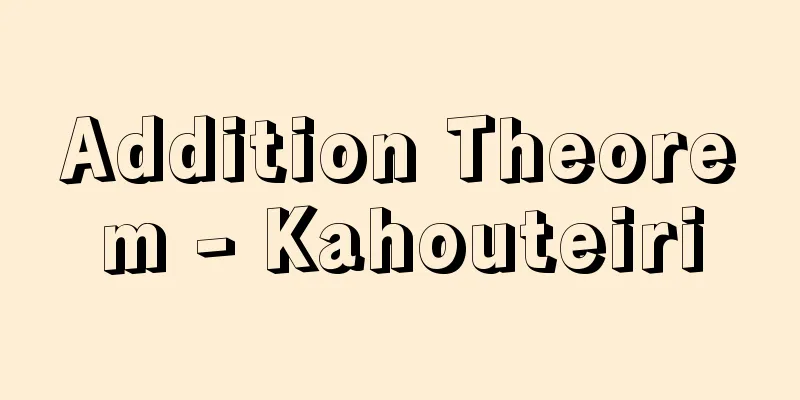Addition Theorem - Kahouteiri

|
There are many types of addition theorems in mathematics, but here we will introduce the following two as the most common ones. (1) The addition theorem of trigonometric functions is the following formula.
p=p(E 1 )+p(E 2 )+……+p(E k ) [Shigeru Furuya] Source: Shogakukan Encyclopedia Nipponica About Encyclopedia Nipponica Information | Legend |
|
数学において加法定理とよばれているものはいろいろあるが、ここではもっとも一般的なものとして次の二つをあげる。 (1)三角関数の加法定理 次の公式をいう。
p=p(E1)+p(E2)+……+p(Ek) [古屋 茂] 出典 小学館 日本大百科全書(ニッポニカ)日本大百科全書(ニッポニカ)について 情報 | 凡例 |
<<: Supersaturation - Kahouwa (English spelling) supersaturation
Recommend
Bad Kande
A North Indian musicologist. Through thorough rese...
Model Wage
-A model of wage trends when a person employed by ...
Togasawara (English spelling) Japanese douglas fir
An evergreen tall tree of the pine family native t...
Adipose fin - Adipose fin
…The fins of herring and salmon lack spines and h...
Diffusion coefficient
When there is no external force, the change in th...
Rudbeckia - Rudbeckia
A general term for the genus Rudbeckia in the Ast...
Korea
...Yi Dynasty scholar Li Yi Yi interpreted Jo as ...
Nuclear medicine
A medical field that uses unsealed radioisotopes o...
Asahi (tobacco) - Asahi
…(2) Tobacco with a tip Until around 1916, the de...
Nonell, I. (English spelling) NonellI
… 19th century European art shifted from Neoclass...
Nation (English spelling)
In French, it means a nation, a nation, or a state...
Cerveteri (English spelling)
A city located about 50 km northwest of Rome. Ther...
Takizawa [village] - Takizawa
A village in Iwate County, located in the center o...
"Iroha Kana Yotsuya Kaidan" - Iroha Kana Yotsuya Kaidan
...It is commonly known as "Yotsuya Kaidan&q...
Costume - Isho
1. Wear it on your upper body Clothing Silk "...









